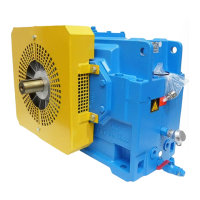58 / 109
BA 5846 en 05/2015
6.6.2.2 Fitting with loose DU bush
The loose DU bush is pushed onto the machine shaft, fixed rigidly in position with a locating tie and then
pulled into the hollow shaft of the gear unit along with the machine shaft (see figure 30).
NOTICE
Material damage
Risk of damage to the gear unit through canting during fitting work.
When fitting the gear unit, care must be taken that the hollow shaft and the machine shaft are aligned and
that the tooth position of the machine shaft relative to the hollow shaft is correct.
The correct tooth position can be determined by turning the input shaft or by swivelling the gear unit lightly
around the hollow shaft.
Instead of the nut and threaded spindle shown in the diagram, other types of equipment such as a hydraulic
cylinder may be used.
NOTICE
Material damage
Risk of damage to the rolling bearings through canting, when the gear unit is fitted.
The hollow shaft may be tightened against a machineshaft collar only if the gearunit configuration is one
of the following:
– Torque arm
6.6.2.3 Axial securing
Depending on type, secure the hollow shaft axially on the machine shaft (e.g. with locking ring, end plate,
set screw).
6.6.3 Demounting
• Remove the axial securing device from the hollow shaft.
• If frictional corrosion has occurred on the seating surfaces, rustreleasing agent may be used to
facilitate forcing off the gear unit. The rust releaser can be injected through the pressureoil connection
(see figure 31), using a pump.
• The end plate and the locking ring must first be removed.
• When the rustreleasing agent has taken effect, pull the gear unit off using the device (see figures 31
and/or figure 32).
• Removing the gear unit from the drivenmachine shaft can be done as follows:
─ preferably using a hydraulic lifting unit,
─ using forcingoff screws in an end plate (see figure 32), or
─ using a central threaded spindle.

